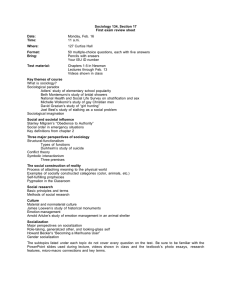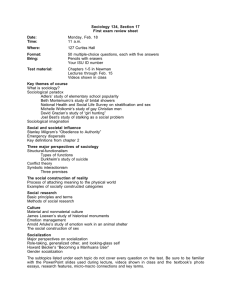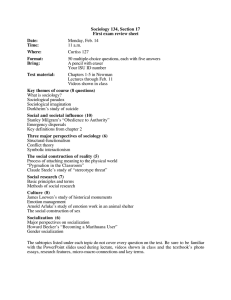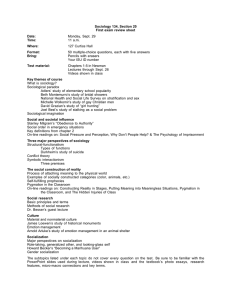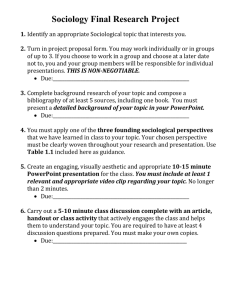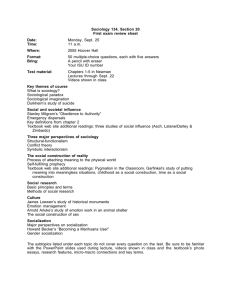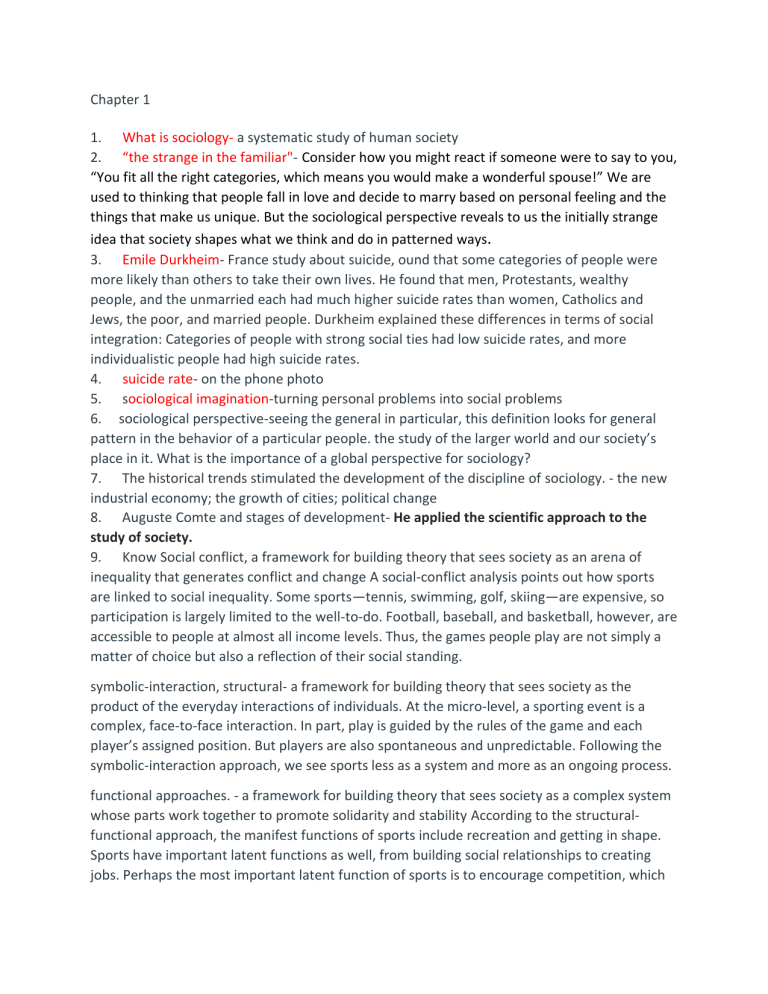
Chapter 1 1. What is sociology- a systematic study of human society 2. “the strange in the familiar"- Consider how you might react if someone were to say to you, “You fit all the right categories, which means you would make a wonderful spouse!” We are used to thinking that people fall in love and decide to marry based on personal feeling and the things that make us unique. But the sociological perspective reveals to us the initially strange idea that society shapes what we think and do in patterned ways. 3. Emile Durkheim- France study about suicide, ound that some categories of people were more likely than others to take their own lives. He found that men, Protestants, wealthy people, and the unmarried each had much higher suicide rates than women, Catholics and Jews, the poor, and married people. Durkheim explained these differences in terms of social integration: Categories of people with strong social ties had low suicide rates, and more individualistic people had high suicide rates. 4. suicide rate- on the phone photo 5. sociological imagination-turning personal problems into social problems 6. sociological perspective-seeing the general in particular, this definition looks for general pattern in the behavior of a particular people. the study of the larger world and our society’s place in it. What is the importance of a global perspective for sociology? 7. The historical trends stimulated the development of the discipline of sociology. - the new industrial economy; the growth of cities; political change 8. Auguste Comte and stages of development- He applied the scientific approach to the study of society. 9. Know Social conflict, a framework for building theory that sees society as an arena of inequality that generates conflict and change A social-conflict analysis points out how sports are linked to social inequality. Some sports—tennis, swimming, golf, skiing—are expensive, so participation is largely limited to the well-to-do. Football, baseball, and basketball, however, are accessible to people at almost all income levels. Thus, the games people play are not simply a matter of choice but also a reflection of their social standing. symbolic-interaction, structural- a framework for building theory that sees society as the product of the everyday interactions of individuals. At the micro-level, a sporting event is a complex, face-to-face interaction. In part, play is guided by the rules of the game and each player’s assigned position. But players are also spontaneous and unpredictable. Following the symbolic-interaction approach, we see sports less as a system and more as an ongoing process. functional approaches. - a framework for building theory that sees society as a complex system whose parts work together to promote solidarity and stability According to the structuralfunctional approach, the manifest functions of sports include recreation and getting in shape. Sports have important latent functions as well, from building social relationships to creating jobs. Perhaps the most important latent function of sports is to encourage competition, which is central to our society’s way of life. 10. manifest functions - the recognized and intended consequences of any social pattern the latent functions- the unrecognized and unintended consequences of any social pattern 11. Critical Sociology- is the study of society that focuses on the need for social change. 12. Scientific Sociology 13. Objectivity/Theory/Biases/Gender issues Androcentricity. Androcentricity (literally, “focus on the male”) means approaching an issue from a male perspective. Sometimes researchers act as if only men’s activities are important, ignoring what women do. For years, sociologists studying occupations focused on the paid labor of men and overlooked the housework and childcare traditionally performed by women. Research that seeks to explain human behavior cannot ignore half of humanity. Gynocentricity—seeing the world from a female perspective—can also limit good sociological investigation. However, in our male-dominated society, this problem arises less often. Overgeneralizing. This problem occurs when sociologists gather data only from men but then use that information to draw conclusions about all people. For example, a researcher might speak to a handful of male public officials and then form conclusions about an entire community. Gender blindness. Failing to consider gender at all is called gender blindness. The lives of men and women differ in many ways. A study of growing old in the United States might suffer from gender blindness if it overlooked the fact that most elderly men live with spouses but elderly women generally live alone. Double standards. Researchers must be careful not to judge men and women by different standards. For example, a family researcher who labels a couple “man and wife” may define the man as the “head of the household” and treat him as important while assuming that the woman simply plays a supporting role. Interference. Another way gender can distort a study is if a subject reacts to the sex of the researcher, interfering with the research operation. While studying a small community in Sicily, for instance, Maureen Giovannini (1992) found that many men treated her as a woman rather than as a researcher. Some thought it inappropriate for an unmarried woman to speak privately with a man. Others denied Giovannini access to places they considered off-limits to women The sociological perspective reveals the power of society to shape individual lives. C. Wright Mills called this point of view the “sociological imagination,” which transforms personal troubles into public issues. Being an outsider or experiencing a social crisis encourages the sociological perspective. The Importance of a Global Perspective Global awareness is an important part of the sociological perspective because where we live shapes the lives we lead. societies throughout the world are increasingly interconnected. what happens in the rest of the world affects life here in the United States. many social problems that we face in the United States are far more serious elsewhere. thinking globally helps us learn more about ourselves. Origins of Sociology Rapid social change helped trigger the development of sociology: rise of an industrial economy explosive growth of cities new political ideas Auguste Comte named the discipline of sociology in 1838. Early philosophers had tried to describe the ideal society, but Comte wanted to understand society as it really is. Karl Marx and many later sociologists used sociology to try to make society better. The sociological perspective is used by government agencies when developing laws and regulations that guide how people in communities live and work. helps us understand the barriers and opportunities in our lives. is an advantage in many fields of work that involve working with people. Sociological Theory 1.3 Summarize sociology’s major theoretical approaches. Macro-Level The structural-functional approach explores how social structures work together to help society operate. Auguste Comte, Emile Durkheim, and Herbert Spencer helped develop the structural-functional approach. The social-conflict approach shows how inequality creates conflict and causes change. Two important types of conflict analysis are gender-conflict theory, which is also called feminist theory, and race-conflict theory. Karl Marx helped develop the social-conflict approach. Micro-Level The symbolic-interaction approach studies how people, in everyday interaction, construct reality. Max Weber and George Herbert Mead helped develop the social-interaction approach. Three Ways to Do Sociology 1.4 Describe sociology’s three research orientations. Positivist sociology uses the logic of science. tries to establish cause and effect demands that researchers try to be objective is loosely linked to structural-functional theory Interpretive sociology focuses on the meanings people attach to behavior. people construct reality in their everyday lives. Weber’s Verstehen is learning how people understand their world. is linked to symbolic-interaction theory Critical sociology uses research to bring about social change. focuses on inequality rejects the principle of objectivity, claiming that all research is political is linked to social-conflict theory Issues Affecting Sociological Research 1.5 Identify the importance of gender and ethics in sociological research. Gender can affect sociological research if a researcher fails to avoid problems of androcentricity, overgeneralizing, gender blindness, double standards, or interference. Research Ethics Sociologists must ensure that subjects in a research project are not harmed and include in their published results all sources of financial support. Research Methods 1.6 Explain why a researcher might choose each of sociology’s research methods. The experiment allows researchers to study cause and effect between two or more variables in a controlled setting. Survey research uses questionnaires or interviews to gather subjects’ responses to a series of questions. Through participant observation, researchers join with people in a social setting for an extended period of time. Researchers use data collected by others from existing sources to save time and money. Ten important steps in carrying our sociological research move from selecting a topic to sharing the results of research. Chapter 2 14. High culture- cultural patterns that distinguish a society’s elite 15. Nonmaterial culture 16. Material culture 17. Norms- rules and expectations with which a society guides the behavior of its members 18. Culture Shock 19. Culture and Survival 20. Cultural transmission- the process by which one generation passes culture to the next 21. values central to U.S. culture 22. economic survival 23. Folkways. norms for routine or casual interaction. 24. Beliefs. -specific thoughts or ideas that people hold to be true. 25. Mores. - ref er to norms that are widely observed and have great moral significance 26. Symbols.anything that carries a particular meaning recognized by people who share a culture 27. Gerhard Lenski argued that a society’s level of technology is crucial in determining what cultural ideas and artifacts emerge or are even possible highlighted the power of technology to shape - 28. industrial society, a postindustrial society 29. High culture. 30. Subculture-. cultural patterns that set apart some segment of a society’s population. 31. Popular culture. - cultural patterns that are widespread among a society’s population. 32. counterculture- cultural patterns that strongly oppose those widely accepted within a society 33. cultural patterns and Immigrants 34. Multiculturalism- a perspective recognizing the cultural diversity of the United States and promoting equal standing for all cultural traditions. 35. Eurocentric- the dominance of European (especially English) cultural patterns 36. Afrocentric- emphasizing and promoting African cultural patterns, which they see as necessary after centuries of minimizing or ignoring the cultural achievements of African societies and African Americans. 37. Cultural diffusion. - it is when the culture dies 38. cultural relativism- the practice of judging a culture by its own standards. 39. Ethnocentrism. - the practice of judging another culture by the standards of one’s own culture 40. Cultural integration. the close relationships of various elements of a cultural system. 41. George Murdock- identified dozens of cultural universals. One common element is the family, which functions everywhere to control sexual reproduction and to oversee the care of children. Funeral rites, too, are found everywhere, because all human communities cope with the reality of death. Jokes are another cultural universal, serving as a safe means of releasing social tensions. 42. Social-conflict, symbolic-interaction, structural-functional approaches, concerning culture 43. Human Freedom and Culture Making the Grade Chapter 2 Culture What Is Culture? 2.1 Explain the development of culture as a human strategy for survival. Culture is a way of life. Culture is shared by members of a society. Culture shapes how we act, think, and feel. Culture is a human trait. Although several species display a limited capacity for culture, only human beings rely on culture for survival. Culture is a product of evolution. As the human brain evolved, culture replaced biological instincts as our species’ primary strategy for survival. We experience culture shock when we enter an unfamiliar culture and are not able to read meaning in our new surroundings. We create culture shock for others when we act in ways they do not understand. The Elements of Culture 2.2 Identify common elements of culture. Culture relies on symbols in the form of words, gestures, and actions to express meaning. The fact that different meanings can come to be associated with the same symbol (for example, a wink of an eye) shows the human capacity to create and manipulate symbols. Societies create new symbols all the time (for example, new computer technology has sparked the creation of new cyber-symbols). Language is the symbolic system by which people in a culture communicate with one another. People use language—both spoken and written—to transmit culture from one generation to the next. Because every culture is different, each language has words or expressions not found in any other language. Values are abstract standards of what ought to be (for example, equality of opportunity). Values can sometimes be in conflict with one another. Lower-income countries have cultures that value survival; higher-income countries have cultures that value individualism and self-expression. Beliefs are specific statements that people who share a culture hold to be true (for example, “A qualified woman can and should be elected president”). Norms, rules that guide human behavior, are of two types: mores (e.g., sexual taboos), matters of great moral significance folkways (e.g., greetings or dining etiquette), matters of everyday politeness Technology and Culture 2.3 Analyze how a society’s level of technology shapes its culture. Culture is shaped by technology. We understand technological development in terms of stages of sociocultural evolution: hunting and gathering horticulture and pastoralism agriculture industry postindustrial information technology Cultural Diversity: Many Ways of Life in One World 2.4 Discuss dimensions of cultural difference and cultural change. We live in a culturally diverse society. This diversity is as a result of our country’s history of immigration. Diversity reflects regional differences, and also differences in social class that set off high culture (available only to elites) from popular culture (available to average people). Subculture is based on differences in interests and life experiences. Hip-hop fans and jocks are two examples of youth subcultures in the United States. Multiculturalism is an effort to enhance appreciation of cultural diversity. Multiculturalism developed in reaction to the melting pot idea, which was thought to result in minorities losing their identity as they adopted mainstream cultural patterns. Counterculture is strongly at odds with conventional ways of life. Any militant group in the United States that would plot to destroy Western society would be an example of a counterculture. Cultural change results from invention (e.g., the telephone and the computer) discovery (e.g., the recognition that women are capable of political leadership) diffusion (e.g., the growing popularity of various ethnic foods and musical styles) Cultural lag results when some parts of a cultural system change faster than others. Ethnocentrism links people to their society but can cause misunderstanding and conflict between societies. Cultural relativism is increasingly important as people of the world come into more contact with each other. Theories of Culture 2.5 Apply sociology’s macro-level theories to gain greater understanding of culture. Structural-functional theory views culture as a relatively stable system built on core values. All cultural patterns play some part in the ongoing operation of society. Social-conflict theory sees culture as a dynamic arena of inequality and conflict. Cultural patterns benefit some categories of people more than others. Feminist theory highlights how culture is “gendered,” dividing activities between the sexes in ways that give men greater power and privileges than women. Sociobiology explores how evolution has shaped patterns of culture in today’s world. Culture and Human Freedom 2.6 Critique culture as limiting or expanding human freedom. Culture can limit the choices we make. As cultural creatures, we have the capacity to shape and reshape our world to meet our needs and pursue our dreams. Chapter 3 41. Socialization- o refer to the lifelong social experience by which people develop their human potential and learn culture. 42. Personality a person’s fairly consistent patterns of acting, thinking, and feeling 43. Harlow- “social isolation” Finally, the Harlows discovered that infant monkeys could recover from about three months of isolation. But by about six months, isolation caused irreversible emotional and behavioral damage. 44. Watson 45. Freud’s theories id (Latin for “it”) represents the human being’s basic drives, which are unconscious and demand immediate satisfaction. Rooted in biology, the id is present at birth, making a newborn a bundle of demands for attention, touching, and food. But society opposes the self-centered id, which is why one of the first words a child typically learns is “no.” ego (Latin for “I”), which is a person’s conscious efforts to balance innate pleasure-seeking drives with the demands of society. The ego arises as we become aware of our distinct existence and face the fact that we cannot have everything we want superego Freud’s term for the cultural values and norms internalized by an individual (Latin for “above or beyond the ego”) is the cultural values and norms internalized by an individual. The superego operates as our conscience, telling us why we cannot have everything we want. The superego begins to form as a child becomes aware of parental demands and matures as the child comes to understand that everyone’s behavior should take account of cultural norms. 46. Anna's story 47. Kohlberg- Lawrence Kohlberg (1981) built on Piaget’s work to study moral reasoning, or how individuals judge situations as right or wrong. Here again, development occurs in stages. Young children who experience the world in terms of pain and pleasure (Piaget’s sensorimotor stage) are at the preconventional level of moral development. At this early stage, in other words, rightness amounts to “what feels good to me.” For example, a young child may simply reach for something on a table that looks shiny, which is the reason parents of young children have to “childproof” their homes. The conventional level, Kohlberg’s second stage, appears by the teen years (corresponding to Piaget’s final, formal operational stage). At this point, young people lose some of their selfishness as they learn to define right and wrong in terms of what pleases parents and conforms to cultural norms. Individuals at this stage also begin to assess intention in reaching moral judgments instead of simply looking at what people do. For example, they understand that stealing food to feed one’s hungry children is not the same as stealing an iPod to sell for pocket change. In Kohlberg’s final stage of moral development, the postconventional level, people move beyond their society’s norms to consider abstract ethical principles. Now they think about liberty, freedom, or justice, perhaps arguing that what is legal still may not be right. When the African American activist Rosa Parks refused to give up her seat on a bus in Montgomery, Alabama, in 1955, she violated that city’s segregation laws to call attention to racial injustice. Evaluate 48. Gilligan- Boys, Gilligan (1982, 1990) claims, have a justice perspective, relying on formal rules to define right and wrong. Girls, by contrast, have a care and responsibility perspective, judging a situation with an eye toward personal relationships and loyalties. For example, as boys see it, stealing is wrong because it breaks the law. Girls are more likely to wonder why someone would steal and to be sympathetic toward a person who steals, say, to feed her family. 49. Mead- Mead’s work explores the character of social experience itself. In the symbolic interaction of human beings, he believed he had found the root of both self and society. Mead’s view is completely social, allowing no biological element at all. This is a problem for critics who stand with Freud (who said our general drives are rooted in the body) and Piaget (whose stages of development are tied to biological maturity). Be careful not to confuse Mead’s concepts of the I and the me with Freud’s id and superego. For Freud, the id originates in our biology, but Mead rejected any biological element of the self (although he never clearly spelled out the origin of the I). In addition, the id and the superego are locked in continual combat, but the I and the me work cooperatively together (Meltzer, 1978). 50. Cooley 51. Erickson- Erik H. Erikson’s Eight Stages of Development Although some analysts (including Freud) point to childhood as the crucial time when personality takes shape, Erik H. Erikson (1902–1994) took a broader view of socialization. He explained that we face challenges throughout the life course ([1950] 1963). Stage 1: Infancy—the challenge of trust (versus mistrust). Between birth and about eighteen months, infants face the first of life’s challenges: to establish a sense of trust that their world is a safe place. Family members play a key part in how any infant meets this challenge. Stage 2: Toddlerhood—the challenge of autonomy (versus doubt and shame). The next challenge, up to age three, is to learn skills to cope with the world in a confident way. Failing to gain self-control leads children to doubt their abilities. Stage 3: Preschool—the challenge of initiative (versus guilt). Four- and five-year-olds must learn to engage their surroundings—including people outside the family—or experience guilt at failing to meet the expectations of parents and others. Stage 4: Preadolescence—the challenge of industriousness (versus inferiority). Between ages six and thirteen, children enter school, make friends, and strike out on their own more and more. They either feel proud of their accomplishments or fear that they do not measure up. Stage 5: Adolescence—the challenge of gaining identity (versus confusion). During the teen years, young people struggle to establish their own identity. In part, teenagers identify with others, but they also want to be unique. Almost all teens experience some confusion as they struggle to establish an identity. Stage 6: Young adulthood—the challenge of intimacy (versus isolation). The challenge for young adults is to form and maintain intimate relationships with others. Making close friends (and especially falling in love) involves balancing the need to bond with the need to have a separate identity. Stage 7: Middle adulthood—the challenge of making a difference (versus self-absorption). The challenge of middle age is contributing to the lives of others in the family, at work, and in the larger world. Failing at this, people become self-centered, caught up in their own limited concerns. Stage 8: Old age—the challenge of integrity (versus despair). As the end-of-life approaches, people hope to look back on what they have accomplished with a sense of integrity and satisfaction. For those who have been self-absorbed, old age brings only a sense of despair over missed opportunities. Gerontocracy-a form of social organization in which the elderly have the most wealth, power, and prestige 52. Socialization agents 53. Goffman- otal institutions have three important characteristics. First, staff members supervise all aspects of daily life, including when and where residents (often called “inmates”) eat, sleep, and work. Second, life in a total institution is controlled and standardized, with the same food, uniforms, and activities for everyone. Third, formal rules dictate when, where, and how inmates perform their daily routines. The purpose of such rigid routines is resocialization, radically changing an inmate’s personality by carefully controlling the environment. Prisons and mental hospitals physically isolate inmates behind fences, barred windows, and locked doors and limit their access to the telephone, mail, and visitors. The institution becomes their entire world, making it easier for the staff to bring about personality change—or at least obedience—in the inmate. 54. Resocialization-radically changing an inmate’s personality by carefully controlling the environment 55. Elisabeth Kübler-Ross Making the Grade Chapter 3 Socialization: From Infancy to Old Age Social Experience: The Key to Our Humanity 3.1 Describe how social interaction is the foundation of personality. Socialization is a lifelong process. Socialization develops our humanity as well as our particular personalities. The importance of socialization is seen in the fact that extended periods of social isolation result in permanent damage (cases of Anna, Isabelle, and Genie). Socialization is a matter of nurture rather than nature. A century ago, most people thought human behavior resulted from biological instinct. For us as human beings, it is our nature to nurture. Understanding Socialization 3.2 Explain six major theories of socialization. Sigmund Freud’s model of the human personality has three parts: id: innate, pleasure-seeking human drives superego: the demands of society in the form of internalized values and norms ego: our efforts to balance innate, pleasure-seeking drives and the demands of society Jean Piaget believed that human development involves both biological maturation and gaining social experience. He identified four stages of cognitive development: The sensorimotor stage involves knowing the world only through the senses. The preoperational stage involves starting to use language and other symbols. The concrete operational stage allows individuals to understand causal connections. The formal operational stage involves abstract and critical thought. Lawrence Kohlberg applied Piaget’s approach to stages of moral development: We first judge rightness in preconventional terms, according to our individual needs. Next, conventional moral reasoning takes account of parental attitudes and cultural norms. Finally, postconventional reasoning allows us to criticize society itself. Carol Gilligan found that gender plays an important part in moral development, with males relying more on abstract standards of rightness and females relying more on the effects of actions on relationships. To George Herbert Mead: The self is part of our personality and includes self-awareness and self-image. The self develops only as a result of social experience. Social experience involves the exchange of symbols. Social interaction depends on understanding the intention of another, which requires taking the role of the other. Human action is partly spontaneous (the I) and partly in response to others (the me). We gain social experience through imitation, play, games, and understanding the generalized other. Charles Horton Cooley used the term looking-glass self to explain that we see ourselves as we imagine others see us. Erik H. Erikson identified challenges that individuals face at each stage of life from infancy to old age. Agents of Socialization 3.3 Analyze how the family, school, peer groups, and the mass media guide the socialization process. The family is usually the first setting of socialization. Family has the greatest impact on attitudes and behavior. A family’s social position, including race and social class, shapes a child’s personality. Ideas about gender are learned first in the family. Schools give most children their first experience with bureaucracy and impersonal evaluation. Schools teach knowledge and skills needed for later life. Schools expose children to greater social diversity. Schools reinforce ideas about gender. The peer group helps shape attitudes and behavior. The peer group takes on great importance during adolescence. The peer group frees young people from adult supervision. Mass media has a huge impact on socialization in modern, high-income societies. The average U.S. child spends as much time watching television and videos as attending school and interacting with parents. Mass media often reinforces stereotypes about gender and race. Mass media exposes people to a great deal of violence. Socialization and the Life Course 3.4 Discuss how our society organizes human experience into distinctive stages of life. The concept of childhood is grounded not in biology but in culture. In high-income countries, childhood is extended. The emotional and social turmoil of adolescence results from cultural inconsistency in defining people who are not children but not yet adults. Adolescence varies by social class. Adulthood is the stage of life when most accomplishments take place. Although personality is now formed, it continues to change with new life experiences. Old age is defined as much by culture as biology. Traditional societies give power and respect to elders. Industrial societies define elders as unimportant and out of touch. The “graying of the United States” means that the average age of our nation’s population is going up. Acceptance of death and dying is part of socialization for the elderly. This process typically involves five stages: denial, anger, negotiation, resignation, and acceptance. Resocialization: Total Institutions 3.5 Characterize the operation of total institutions. Total institutions include prisons, mental hospitals, and monasteries. Staff members supervise all aspects of life. Life is standardized, with all inmates following set rules and routines. Resocialization is a two-part process: breaking down inmates’ existing identity building a new self through a system of rewards and punishments
